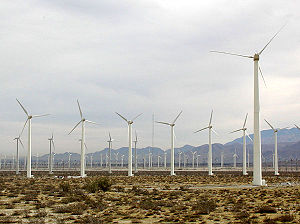Wind: Difference between revisions
imported>Milton Beychok (→Exploitation: Added a photo) |
mNo edit summary |
||
| (4 intermediate revisions by 2 users not shown) | |||
| Line 1: | Line 1: | ||
{{subpages}} | {{subpages}} | ||
{{TOC|right}} | |||
'''Wind''', the movement of air, is a [[meteorology|meteorological]] phenomenon that plays an integral part in activities ranging from the production of [[electricity]] to the creation of myth. It is one of the natural elemental forces of the world. Wind can be felt, and its effects can be observed and measured, but wind itself cannot be seen. It is an invisible force that assists in weather change, and provides power to machines that take advantage of it. | '''Wind''', the movement of air, is a [[meteorology|meteorological]] phenomenon that plays an integral part in activities ranging from the production of [[electricity]] to the creation of myth. It is one of the natural elemental forces of the world. Wind can be felt, and its effects can be observed and measured, but wind itself cannot be seen. It is an invisible force that assists in weather change, and provides power to machines that take advantage of it. | ||
| Line 14: | Line 15: | ||
==Exploitation== | ==Exploitation== | ||
{{Image| | {{Image|WindFarm2.jpg|right|300px|Wind turbine farm in Germany.}} | ||
Since the dawn of the [[windmill]], the ability to convert wind from a force to a source of work has evolved into the ability to exploit wind currents into a viable source of alternative energy. Large electric-windmill farms have been set up in mountainous areas to generate sufficient electricity to subsidise the electrical need of small cities. The advantage of this energy source is that it is non-polluting and "renewable" (in the sense that it never really expires; the amount of energy throughput is dependant on [[weather]] conditions).<ref>{{cite book|author=Tony Burton, David Sharpe, Nick Jenkins and Ervyn Bossanyi|title=Wind Energy Handbook|edition=1st Edition|publisher=John Wiley & Sons|year=2001|id=ISBN 0-471-48997-2}}</ref><ref>{{cite book|author=Saithyajth Mathew|title=Wind Energy: Fundamentals, Resource Analysis and Economics|edition=|publisher=Springer|year=2006|id=ISBN 3-540-30905-5}}</ref> | |||
Since the dawn of the [[windmill]], the ability to convert wind from a force to a source of work has evolved into the ability to exploit | |||
==References== | ==References== | ||
{{reflist}} | {{reflist}} | ||
[[Category:Suggestion Bot Tag]] | |||
Latest revision as of 17:00, 8 November 2024
Wind, the movement of air, is a meteorological phenomenon that plays an integral part in activities ranging from the production of electricity to the creation of myth. It is one of the natural elemental forces of the world. Wind can be felt, and its effects can be observed and measured, but wind itself cannot be seen. It is an invisible force that assists in weather change, and provides power to machines that take advantage of it.
There are many myths and stories behind the power of wind;[1] it seemingly comes from nowhere, but is recognized as an invisible force. Polytheistic religions often attributed the power of wind to a deity, or a servant.
Causes
Wind is actually the motion of air, produced by a change in heat on the Earth's surface. As different parts of the Earth heat up, the air in those parts rises as the cooler parts cause air to sink. This change in temperature generates the motion of air.
Effects
Next to earthquakes and floods, wind can be the cause of some of the worst types of natural disasters. Typhoons, hurricanes, tornadoes, and dust storms are all a side effect of massive wind currents, causing some of the greatest amounts of property damage.
Exploitation
Since the dawn of the windmill, the ability to convert wind from a force to a source of work has evolved into the ability to exploit wind currents into a viable source of alternative energy. Large electric-windmill farms have been set up in mountainous areas to generate sufficient electricity to subsidise the electrical need of small cities. The advantage of this energy source is that it is non-polluting and "renewable" (in the sense that it never really expires; the amount of energy throughput is dependant on weather conditions).[2][3]
References
- ↑ Jan DeBlieu (1998). Wind: How the Flow of Air Has Shaped Life, Myth and the Land. Houghton Mifflin Harcourt. ISBN 0-395-78033-0.
- ↑ Tony Burton, David Sharpe, Nick Jenkins and Ervyn Bossanyi (2001). Wind Energy Handbook, 1st Edition. John Wiley & Sons. ISBN 0-471-48997-2.
- ↑ Saithyajth Mathew (2006). Wind Energy: Fundamentals, Resource Analysis and Economics. Springer. ISBN 3-540-30905-5.
